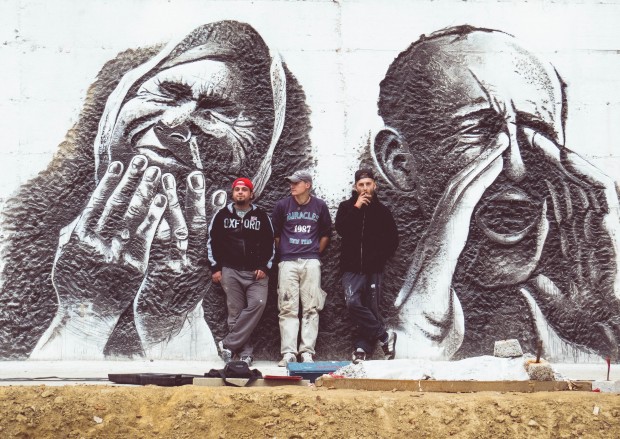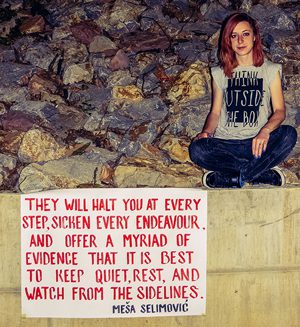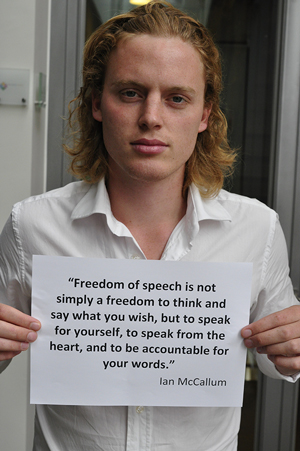Index relies entirely on the support of donors and readers to do its work.
Help us keep amplifying censored voices today.

Artist collective HAD and their memorial for the victims of Srebrenica genocide. (Photo: Ilhana Babić)
This month, the Index Youth Advisory Board members were asked to write a blog post exploring their opinions on censorship in the arts by citing a case.
Lejla Becar: Memorial to victims of Srebrenica massacre
In the small town Visoko, Bosnia and Herzegovina, a square was opened on 5 October to commemorate the victims of Srebrenica genocide. The construction of the square has since been in the spotlight as a large number of citizens disapproved of it being built, seeing it as overpriced and unnecessary.
Local artist collective HAD, made up of Muhamed Hamo Bešlagić, Anel Lepić and Damir Sarač, decided to contribute to keeping the memory of the victims alive. They decorated a 35-meter long wall nearby the square with images of war victims, focusing on Srebrenica genocide victims. They went to the authorities and suggested their work, which they named Silence, and it was approved. The three of them, an architecture student, a painter and a street artist, chose to work for free, feeling the moral obligation to keep the memory of the victims alive for future generations.
Once they started working on carving the images into the wall, they faced objections from their fellow citizens. People were disgusted with what they saw, and many approached the artists while they were working, expressing their disapproval of having such images shoved in their faces.
The accusations continue, however HAD continue with their work. They said: “Every quality artwork has to have negative critiques and negative comments. We somehow maybe even prefer the negative ones, they often show a deeper understanding of the work, they show that people pondered deeply. Indifference is absent when it comes to Silence. Everybody has some kind of reaction. That was one of our goals — to make the images speak for themselves by remaining completely silent.”
Twenty years after the war it seems people still don’t want to face what happened. Many look the other way, people say they remember when all they want to do is forget. HAD decided that Srebrenica genocide will not be remembered only on 11 July and they carved their decision in a concrete wall. Showing the true power of art.
Simeon Gready: #RememberMarikana graffiti
16 August 2015 marked the third anniversary of the Marikana massacre in South Africa, a day of remembrance in honour of the striking miners that lost their lives through lethal force by security forces in the country. It was an incident that reverberated worldwide and represented a black mark on South Africa’s progress as a democracy and a tragic consequence of the country’s increasingly rampant inequality.
Three years on, there is still no justice for the victims of the massacre, a group of anonymous artists under the banner of Tokolos Stencil Collective claimed responsibility for a series of graffiti and stencil statements on the campus of the University of Cape Town (UCT), indicating the University for its complicity in the massacre.
Statements such as “#RememberMarikana”, “non-poor only”, and “Max Price [UCT’s vice-chancellor] For Black Lives”, were framed as a form of protest against UCT’s investment in Lonmin, the mining company that owned the mine at which the massacre took place. Furthermore, it raised attention to the fact that judge Ian Farlam sits on the UCT Council while heading up the Marikana commission, the committee tasked with the official inquiry into the killings. His position and UCT’s investments are seen as a direct conflict of interest.
The university was quick to condemn the graffiti as an “irresponsible and inappropriate method of protest,” and many of the statements were removed within a week.
However, this was not enough to quell the discontent among the students. Despite the condemnation and removal, the graffiti exposed UCT’s investments in Lonmin and, as such, their association with South Africa’s darkest post-apartheid day.
Graffiti, in this manner, constitutes an appropriate and effective form of art and of protest. It is a tool through which the Tokolos Stencil Collective were able to express their right to freedom of expression and represent the dissatisfaction of the students with the actions of the university.
Harsh Ghildiyal: Agnes of God
In the late 1970s, Maureen Murphy was found bleeding in her room, with a wastebasket near her that contained a dead baby, asphyxiated. Sister Maureen Murphy, who was a nun, denied giving birth and stated that she didn’t remember being pregnant. There was a trial, and she was found not guilty of all charges by reason of insanity.
This incident bears similarities to a play (which also opened on Broadway in 1982), Agnes of God, that portrays a pregnant nun contending that the child was the result of a virgin conception (immaculate conception), followed by an investigation, with the play focusing on exchanges between the nun in charge of the convent and a psychiatrist. The play did not attract any criticism, even after it had been made into a film and was shown all over the world. Over two decades ago, the play was performed in Mumbai, India, too, and was very successful. There were no objections.
An adaptation of the Broadway play was set to premiere in Mumbai on the 4 October 2015 but on the 30 September, the director of the play tweeted that the show was canceled, citing threats of arrest, imprisonment, harm to body and property as reasons behind the decision. The Catholics Bishops Conference of India and Catholic Secular Forum contended that it is a wrongful portrayal of the character of clergy and hurts religious sentiments, and jointly sought a ban on the play.
This move to get the play banned can perhaps be attributed to the increasing number of intolerant people impatiently waiting to be offended, coupled with the ease of getting things banned in India (be it on religious or moral grounds). The increasingly intolerant society is proving to be a major hindrance to the freedom of expression of individuals in India. I would like to end by quoting a few sentences from Justice Chinnappa Reddy’s judgment in a case concerning expulsion of children who were Jehovah’s Witnesses on the grounds that they refused to sing the national anthem: “Our tradition teaches tolerance; our philosophy preaches tolerance; our Constitution practises tolerance; let us not dilute it.”
Matthew Brown: Isis Threaten Sylvania
In commenting on the decision to remove artwork from the Passion for Freedom art festival in London, I have rarely seen such an inexplicable and frankly ludicrous example of censorship in modern-day Britain.
The work in question, Isis Threaten Sylvania by artist Mimsy, is a satirical swipe at Isis and consists of seven scenarios featuring children’s toys as the Sylvanian Families. Depicting toy mice — or MICE-IS — it has been branded as “potentially inflammatory content”. The “contentious” point which has caused the hysterical reaction has been that in the backdrop to each scene, with the mice waving black flags and plotting to disturb the tranquil world of Sylvanian Families.
Perhaps the most farcical aspect of this entire story is that the artwork was due to be exhibited at an event specifically designed to reflect the full spectrum of artistic expression. The exhibition is designed specifically to give artists an opportunity to be provocative, open debate and exercise their freedom of speech. For the police to intervene on the simple grounds that the work is “potentially” provoking isn’t just ludicrous, it is dangerous and raises important questions about the scope of police powers in the world of art.
When we reach a point that art depicting toy to depict a terrorist threat is considered too dangerous for public consumption, one has to wonder what we are really fighting for. If this artwork offends to the point it is banned, then what separates us from the other side? We are either defeated by the enemy or we censor ourselves in this hysterical rush to prevent the potential of offending anyone.
Tom Carter: Isis Threaten Sylvania
After the board took the decision to remove artwork from the exhibition after facing a £36,000 security bill for the six day show.
Satire through art is meant to be humorous, but it has a purpose beyond this, often constructing genuine social criticism. If, due to the threat of intimidation and violence, individuals and organisations feel unable to express themselves then the notion of freedom of expression has very little meaning.
Mimsy, stated her motivation behind the work was to use Sylvanian characters, such as cats and koalas, to show criticism of radical Islam is nothing to do with race, telling the Guardian: “I’m sick and tired of people calling criticism of fanatical Islam racist, because racism is about your skin colour and radical Islam is nothing to do with that. There are millions of Muslims who are shocked by it too.”
Art has a key place in our democracy in creating social criticism and generating political thought in individuals. It is interesting that a country which puts large amounts of public money into actively promoting art forms that would have a much smaller presence if left to the market is unwilling to put money into protecting its population’s right to express itself freely. Artists must be free to criticise and satirise religious extremists.
Secular bloggers in Bangladesh are fearing for their lives as four fellow bloggers were killed by machete-wielding extremists in the country earlier this year. Those murdered formed part of a hit list of 84 secularists and atheists targeted by Islamic fundamentalist groups for expressing their views online. The list was first circulated in 2013.
One of the bloggers, Bangladeshi-born US citizen Avijit Roy, set up the community blog Mukto-Mona. He was murdered with a machete in Dhaka in February. His wife was also wounded during the attack. Roy’s murder was followed by that of fellow secular bloggers Ananta Bijoy Das, Niloy Chatterjee and Washiqur Rahman. Threats to Chatterjee’s life were ignored by police.
Many writers in Bangladesh now fear they will suffer the same fate, with a number of them under 24-hour police protection. While five men, including one British citizen, have been arrested in connection with the murders, no charges have been made.
In response to the attacks, each member of Index on Censorship’s Youth Advisory Board has been asked to produce a short video urging Bangladesh’s government to do more to protect bloggers’ rights to free speech and prevent further killings.
One board member from the US, Muira McCammon, who is currently studying for a masters in translation studies, explains how the Bangladeshi government’s reluctance to protect bloggers is leading people to question online safety. Her compatriot states that the views of atheists are just as important as those with religious beliefs.
South African human rights advocate Simeon Gready, along with two friends from Justice and Peace Netherlands, wants to raise awareness of bloggers under threat in Bangladesh.
The videos are compiled in the playlist below.
This is the ninth of a series of posts written by members of Index on Censorship’s youth advisory board.
Members of the board were asked to write a blog discussing one free speech issue in their country. The resulting posts exhibit a range of challenges to freedom of expression globally, from UK crackdowns on speakers in universities, to Indian criminal defamation law, to the South African Film Board’s newly published guidelines.

Lejla Becar is a member of the Index youth advisory board. Learn more
In 2005, the chair of Visoko municipality cancelled a concert due to be performed by Skroz, a rock band from Bosnia and Herzegovina. He justified his decision by saying that the concert and the sponsor (a famous beer brand) would be insulting for Muslims and Muslim youth.
These decisions riled up both the organisers of the events and also citizens, both Muslim and non-Muslim. One of the main organisers was Adnan Jašo Jašarspahić, editor of independent radio station Radio Q. He was to face consequences in the years to come due to his decision not to obey the chair and ignore the cancellation of the Skroz concert. It was held 15 days after cancellation.
This was not an isolated event. In 2006 Croatian band Let 3 were not allowed to perform in Travnik, a small municipality in central Bosnia. In 2008, Bosnian group Dubioza Kolektiv were banned from performing in Goražde. In the meantime, the Communications Regulatory Agency (CRA) penalised Bosnian radio station Radio 202 — fining them more than €5,000 — for playing hip-hop music on air. The agency stated it had been offensive.
The situation now? In my town, cultural events for youth are a phenomena. More and more young people are leaving, turning to radical Islam or simply living within an oppressive system without complaint. The people fighting the system were silenced. Ten years of violating the right to freedom of expression took its toll and now the government has succeeded in creating a society that is obedient, ignorant and passive.
Lejla Becar, Bosnia and Herzegovina
Related:
• Anastasia Vladimirova: A ruthless crackdown on independent media
• Simeon Gready: An over-the-top regulation policy
• Ravian Ruys: Without trust, free speech suffers
• Muira McCammon: GiTMO’s linguistic isolation
• Jade Jackman: An act against knowledge and thought
• Harsh Ghildiyal: Defamation is not a crime
• Tom Carter: No-platforming Nigel
• Matthew Brown: Spying on NGOs a step too far
• About the Index on Censorship youth advisory board
• Facebook discussion: no-platforming of speakers at universities
This is the seventh of a series of posts written by members of Index on Censorship’s youth advisory board.
Members of the board were asked to write a blog discussing one free speech issue in their country. The resulting posts exhibit a range of challenges to freedom of expression globally, from UK crackdowns on speakers in universities, to Indian criminal defamation law, to the South African Film Board’s newly published guidelines.

Simeon Gready is a member of the Index youth advisory board. Learn more
Earlier this year, South Africa’s Film and Publication Board (FPB) released their Draft Online Regulation Policy.
The proposed regulations of this policy have huge implications for freedom of expression in South Africa, which can be summarised into the following:
• The policy claims to apply to films, games and “certain publications”. This is vague language that allows it to cover anyone publishing anything on the Internet.
• The policy allows for regulation of private personal communications.
• The policy states that anyone wishing to publish content on the internet need to apply and pay for an agreement with the FPB, meaning that individuals would be required to pay for their fundamental human right to freedom of expression.
• The policy further violates freedom of expression in that it asserts that it retains the right to take down “violent” content published by media outlets, thereby disallowing the media from being able to carry out its social responsibilities.
• The policy allows “classifiers” from the FPB to search distributor’s premises, unhindered and with no responsibility for loss or damage.
Worryingly, it has recently been announced that this policy has been approved to inform a new film and publications amendment bill. If signed into law, the repressive tactics outlined above could become a reality for South African citizens.
Simeon Gready, South Africa
Related:
• Anastasia Vladimirova: A ruthless crackdown on independent media
• Ravian Ruys: Without trust, free speech suffers
• Muira McCammon: GiTMO’s linguistic isolation
• Jade Jackman: An act against knowledge and thought
• Harsh Ghildiyal: Defamation is not a crime
• Tom Carter: No-platforming Nigel
• Matthew Brown: Spying on NGOs a step too far
• About the Index on Censorship youth advisory board
• Facebook discussion: no-platforming of speakers at universities